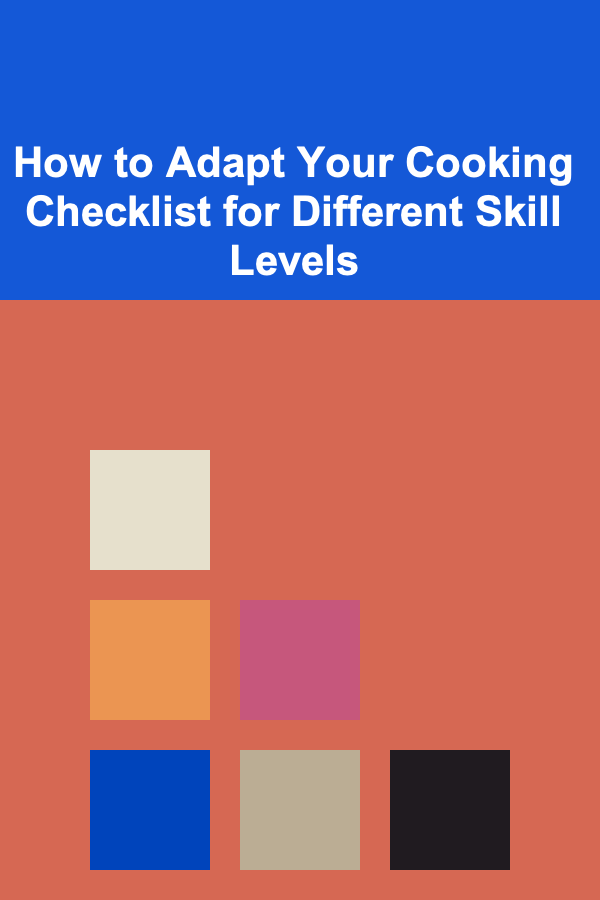
How to Adapt Your Cooking Checklist for Different Skill Levels
ebook include PDF & Audio bundle (Micro Guide)
$12.99$10.99
Limited Time Offer! Order within the next:

Cooking is both an art and a science, and much like any other skill, it requires practice, patience, and a willingness to learn. Whether you're a beginner learning the basics or a seasoned chef honing your culinary techniques, having a cooking checklist can be a valuable tool to ensure that each dish is prepared to perfection. However, the complexity of this checklist can vary greatly depending on the skill level of the cook. A checklist for a novice will look very different from one designed for an experienced chef.
In this article, we'll explore how to adapt your cooking checklist based on different skill levels, from beginner to advanced, while focusing on the essential skills and tools needed at each stage. By the end, you'll have a comprehensive understanding of how to structure a cooking checklist that helps cooks at all stages of their culinary journey.
Understanding Skill Levels in Cooking
Before diving into how to adapt a cooking checklist, it's important to understand the different skill levels in cooking. Broadly speaking, cooks can be classified into the following categories:
1. Beginner Cooks
Beginner cooks are those who are just starting their culinary journey. They may be unfamiliar with basic cooking techniques and terminology and are still learning how to handle kitchen tools safely. A beginner cook typically focuses on simple, straightforward dishes that require minimal prep time and basic equipment.
2. Intermediate Cooks
Intermediate cooks have some experience in the kitchen and are comfortable with more advanced cooking techniques. They can follow a recipe without much guidance, and they might even experiment with flavor combinations. However, they may still struggle with advanced techniques like sauce-making, intricate knife skills, or timing multiple components of a meal.
3. Advanced Cooks
Advanced cooks, or seasoned chefs, have a deep understanding of culinary techniques and an extensive knowledge of ingredients and flavors. They can handle complex dishes with multiple components, and they are skilled in everything from fine knife work to managing multiple cooking processes simultaneously. At this level, cooks may also develop their own recipes or refine existing ones to suit their taste and creativity.
Each skill level requires different approaches when it comes to creating a checklist. A beginner will need to focus on fundamental skills, while an advanced cook will be concerned with more nuanced details and timing.
Creating a Checklist for Beginner Cooks
Key Focus Areas for Beginners
For beginner cooks, the checklist should serve as a guide to ensure they can handle basic tasks in the kitchen. At this stage, the goal is to develop a foundation of cooking skills and familiarity with kitchen tools.
-
Kitchen Setup and Safety
- Pre-Cooking Prep: Ensure the kitchen is clean, organized, and stocked with basic tools like knives, cutting boards, measuring cups, and pots and pans.
- Safety Measures: Always start by reinforcing kitchen safety, such as using oven mitts, being aware of knife safety, and keeping the kitchen clean to avoid cross-contamination.
-
Recipe Selection
- Choose simple recipes with clear instructions. Recipes like pasta, stir-fries, and salads are perfect for beginners.
- Focus on a small number of ingredients that are easy to handle and recognize.
-
Basic Cooking Techniques
- Boiling, Sautéing, and Baking: Focus on basic cooking methods that are easy to execute. For example, boiling pasta, sautéing vegetables, or baking a simple sheet-pan dinner.
- Chopping and Prepping: Basic knife skills like chopping onions, dicing tomatoes, and mincing garlic. Teach proper knife handling to avoid accidents.
-
Time Management
- Create a timeline for preparing each dish. For example, chop the vegetables first, then begin cooking the protein, and finally prepare any garnishes or sauces.
- Emphasize the importance of multitasking, such as boiling water while prepping vegetables.
-
Measuring and Seasoning
- Encourage beginners to measure ingredients carefully. Proper measurement ensures consistency in taste and texture.
- Teach how to taste food throughout the cooking process to adjust seasoning.
-
Cleanup
- Cleaning as you go is a valuable habit for beginners to develop. This ensures a tidy kitchen and makes the cooking process less overwhelming.
Sample Beginner Checklist
- Prep Kitchen: Clean workspace, gather tools, check ingredient list.
- Recipe Review: Read through the recipe thoroughly.
- Basic Cooking Techniques: Master the basic methods like sautéing, boiling, and baking.
- Measuring Ingredients: Accurately measure all ingredients before starting.
- Cook: Follow recipe instructions step by step.
- Season and Taste: Adjust seasoning as needed.
- Clean as You Go: Wash dishes and wipe down surfaces during cooking.
- Serve and Enjoy: Plate the food and serve it with confidence.
Adapting the Checklist for Intermediate Cooks
Intermediate cooks are ready to handle more complex dishes and start experimenting in the kitchen. At this stage, the checklist should reflect the need for more sophisticated techniques and multitasking skills.
Key Focus Areas for Intermediate Cooks
-
Recipe Selection and Ingredient Substitutions
- At this stage, cooks can handle more complex recipes, such as casseroles, soups, or roasted meats. They may also begin to experiment with ingredient substitutions to suit personal preferences or dietary restrictions.
- Challenge intermediate cooks to try new ingredients or cooking methods.
-
Advanced Cooking Techniques
- Sautéing, Roasting, Braising: Intermediate cooks should be comfortable with these techniques. They should also understand the principles behind each method, such as when to roast instead of sauté.
- Knife Skills: At this stage, cooks should be proficient in chopping, julienning, and dicing with precision. Teach how to handle more advanced cuts like chiffonade or brunoise.
-
Time and Temperature Control
- Stress the importance of monitoring cooking times and temperatures. For example, cooking meat to the desired doneness or simmering a soup at the correct heat to avoid burning.
- Intermediate cooks should learn how to juggle multiple dishes at once, ensuring that everything comes together at the right time.
-
Presentation and Plating
- While beginners focus primarily on taste, intermediate cooks should begin to think about presentation. Encourage them to plate their food thoughtfully, using garnishes, color contrasts, and portion control.
-
Understanding Flavor Profiles
- Intermediate cooks should start experimenting with different spices, herbs, and seasoning combinations. Encourage them to recognize the balance between sweet, salty, sour, and bitter flavors and how to achieve harmony in a dish.
-
Ingredient Prep and Mise en Place
- A more advanced level of mise en place (everything in its place) should be emphasized. This includes preparing all ingredients ahead of time and having them ready for the cooking process, which allows for more seamless multitasking.
Sample Intermediate Checklist
- Prep Kitchen and Tools: Clean workspace, gather advanced tools (e.g., thermometer, mandolin).
- Review Recipe and Make Substitutions: Evaluate the recipe, make substitutions where necessary.
- Knife Skills: Practice advanced cutting techniques (julienne, chiffonade).
- Cook Multiple Dishes: Plan and cook dishes that require more multitasking.
- Time Management: Keep track of cooking times and temperatures.
- Taste and Adjust: Experiment with seasoning and flavor combinations.
- Plating and Presentation: Focus on presentation, using garnishes and thoughtful plating.
- Cleanup: Continue cleaning as you go, ensuring everything is washed and organized.
Adapting the Checklist for Advanced Cooks
Advanced cooks, or professional chefs, have the skills to prepare complex dishes and manage multiple components of a meal simultaneously. At this stage, the checklist should focus on precision, timing, and creativity.
Key Focus Areas for Advanced Cooks
-
Recipe Creation and Modification
- Advanced cooks should be comfortable creating their own recipes or modifying existing ones. Encourage experimentation with flavors, textures, and techniques.
- They should also understand how to scale recipes up or down depending on the number of servings needed.
-
Mastering Techniques
- Techniques like sous-vide, molecular gastronomy, or pastry creation are essential for advanced cooks. These methods require precise control of temperature, timing, and technique.
- Mastering advanced knife techniques, such as filleting fish or butchering meat, should be a priority.
-
Multitasking and Efficiency
- Advanced cooks often manage several dishes simultaneously, ensuring everything is prepared to perfection. They need to excel in timing, ensuring that each dish is ready at the same time and served at the correct temperature.
- Stress the importance of working efficiently in the kitchen, minimizing unnecessary steps or wasted movements.
-
Fine-Tuning Flavors and Presentation
- At this level, flavor balance is key. Advanced cooks should be able to identify and correct flavor imbalances intuitively.
- Presentation is also paramount, with an emphasis on creating visually stunning dishes that reflect the artistry of the cook.
-
Mentorship and Teaching
- Advanced cooks should be able to mentor others, teaching skills, techniques, and kitchen efficiency to less experienced cooks.
-
Professional Kitchen Management
- Advanced cooks may be responsible for managing kitchen operations, from inventory control to team coordination. They must ensure that the kitchen is organized, staff are trained, and the operation runs smoothly.
Sample Advanced Checklist
- Create or Modify Recipe: Experiment with flavors, textures, and techniques.
- Master Advanced Techniques: Implement sous-vide, molecular gastronomy, or pastry techniques.
- Multitask Efficiently: Prepare and cook multiple dishes with precise timing.
- Perfect Flavor Balance: Adjust seasoning and flavors with precision.
- Presentation: Create visually stunning and thoughtfully presented dishes.
- Mentor and Teach: Guide junior cooks and improve team efficiency.
- Kitchen Management: Oversee kitchen operations, manage inventory, and train staff.
Conclusion
Adapting your cooking checklist to suit different skill levels is crucial for any cook's development. By providing the right tools, techniques, and strategies, you can ensure that each cook, from beginner to advanced, is able to navigate the complexities of the kitchen with confidence. Whether you're just learning to boil an egg or mastering the art of molecular gastronomy, a well-tailored checklist can help guide you through the process and lead to culinary success.
Reading More From Our Other Websites
- [Personal Care Tips 101] How to Use Toner to Hydrate Your Skin After Cleansing
- [Home Storage Solution 101] How to Store Holiday Decor Efficiently Without the Clutter
- [Horseback Riding Tip 101] How to Maintain Your Bike for Optimal Performance on Rugged Trails
- [Personal Care Tips 101] How to Use a Face Mask to Combat Oily Skin
- [Personal Care Tips 101] How to Use Music for Stress Reduction and Better Mental Health
- [Digital Decluttering Tip 101] The Psychology of File Names: Boosting Findability and Productivity
- [Paragliding Tip 101] Behind the Wings: Insider Tips from Top Paragliding Influencers on Brand Collaboration
- [Stamp Making Tip 101] Maintaining Sharpness: Tips to Keep Your Carved Stamps Pristine Over Time
- [Home Lighting 101] How to Style Wall Sconces to Enhance Your Home's Ambiance
- [Stamp Making Tip 101] Budget-Friendly Stamp Making Tools: Getting Creative Without Breaking the Bank

Earning Passive Income by Developing and Selling AI Tools
Read More
How to Develop an Emergency Plan for Rental Properties
Read More
How to Set Clear Expectations for Your Virtual Assistant in a Dropshipping Business
Read More
How To Navigate Business Failure and Start Over
Read More
Swimming for Weight Loss: A Comprehensive Guide
Read More
Mastering VR UI/UX Design
Read MoreOther Products

Earning Passive Income by Developing and Selling AI Tools
Read More
How to Develop an Emergency Plan for Rental Properties
Read More
How to Set Clear Expectations for Your Virtual Assistant in a Dropshipping Business
Read More
How To Navigate Business Failure and Start Over
Read More
Swimming for Weight Loss: A Comprehensive Guide
Read More